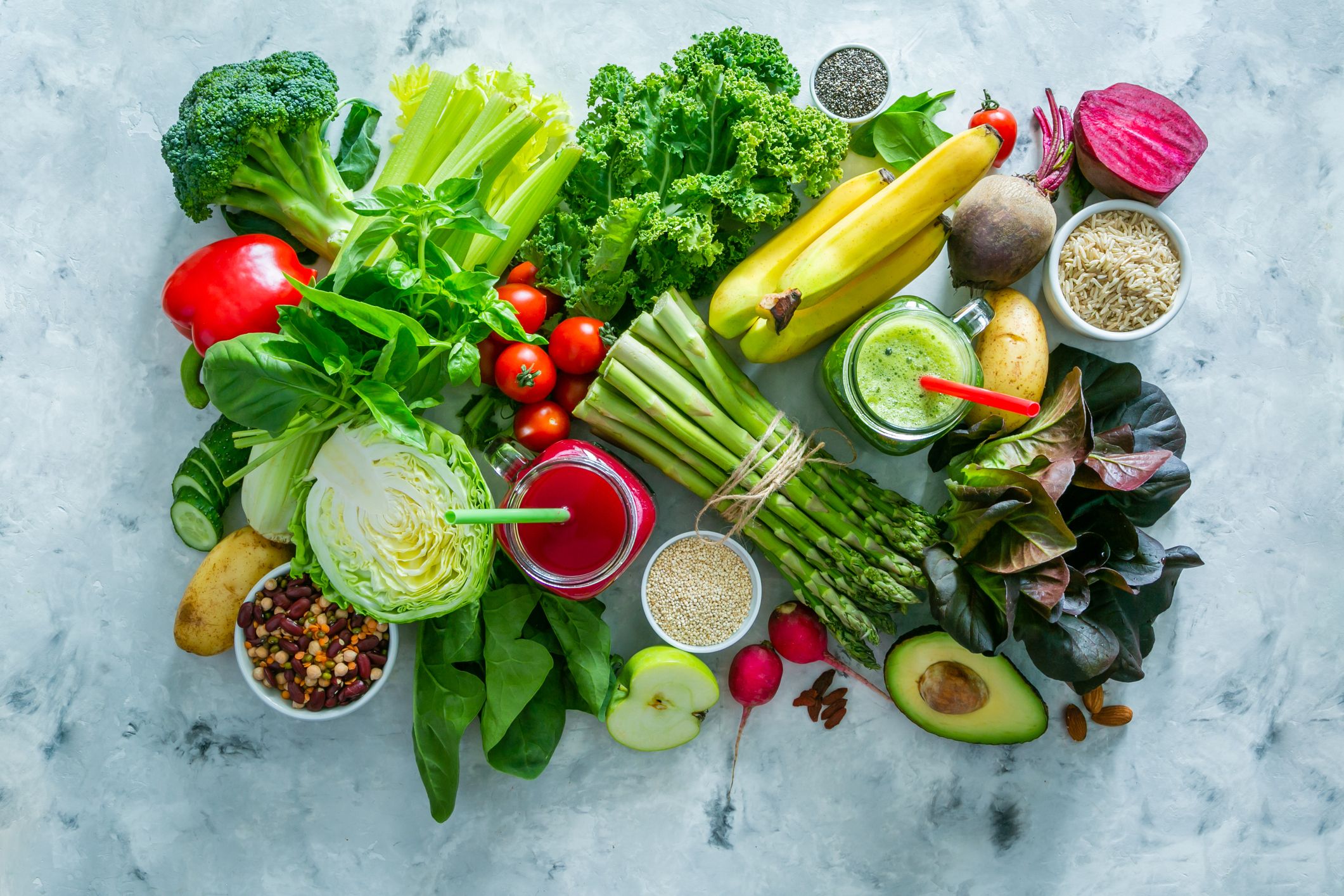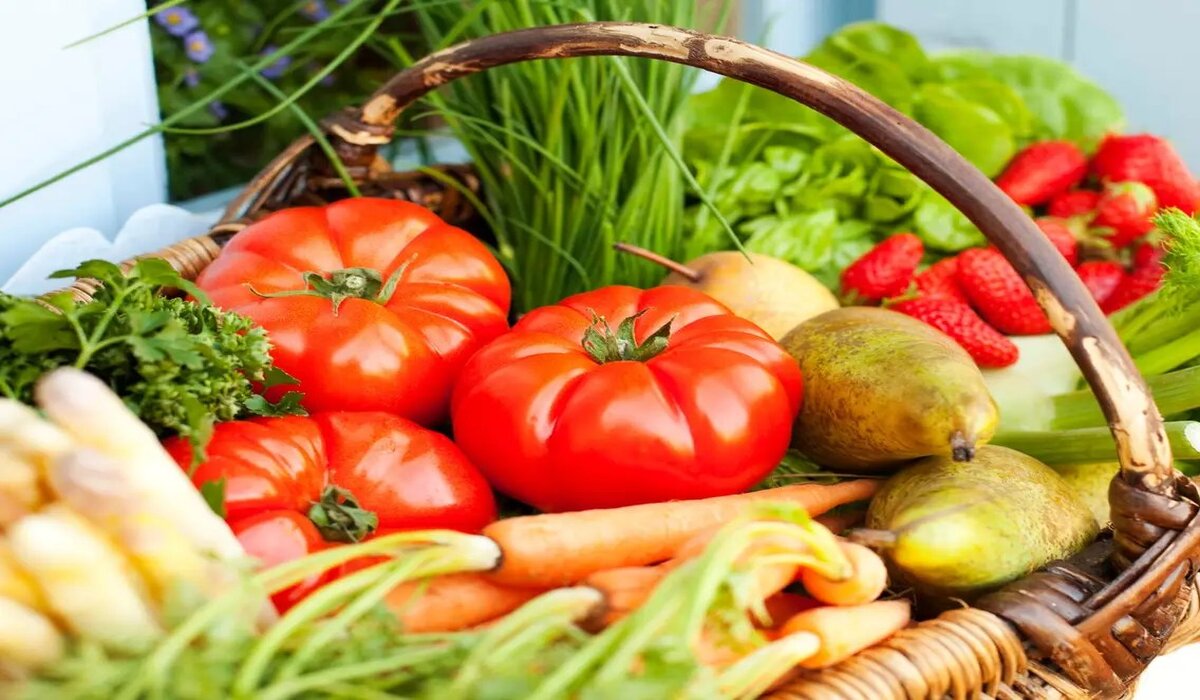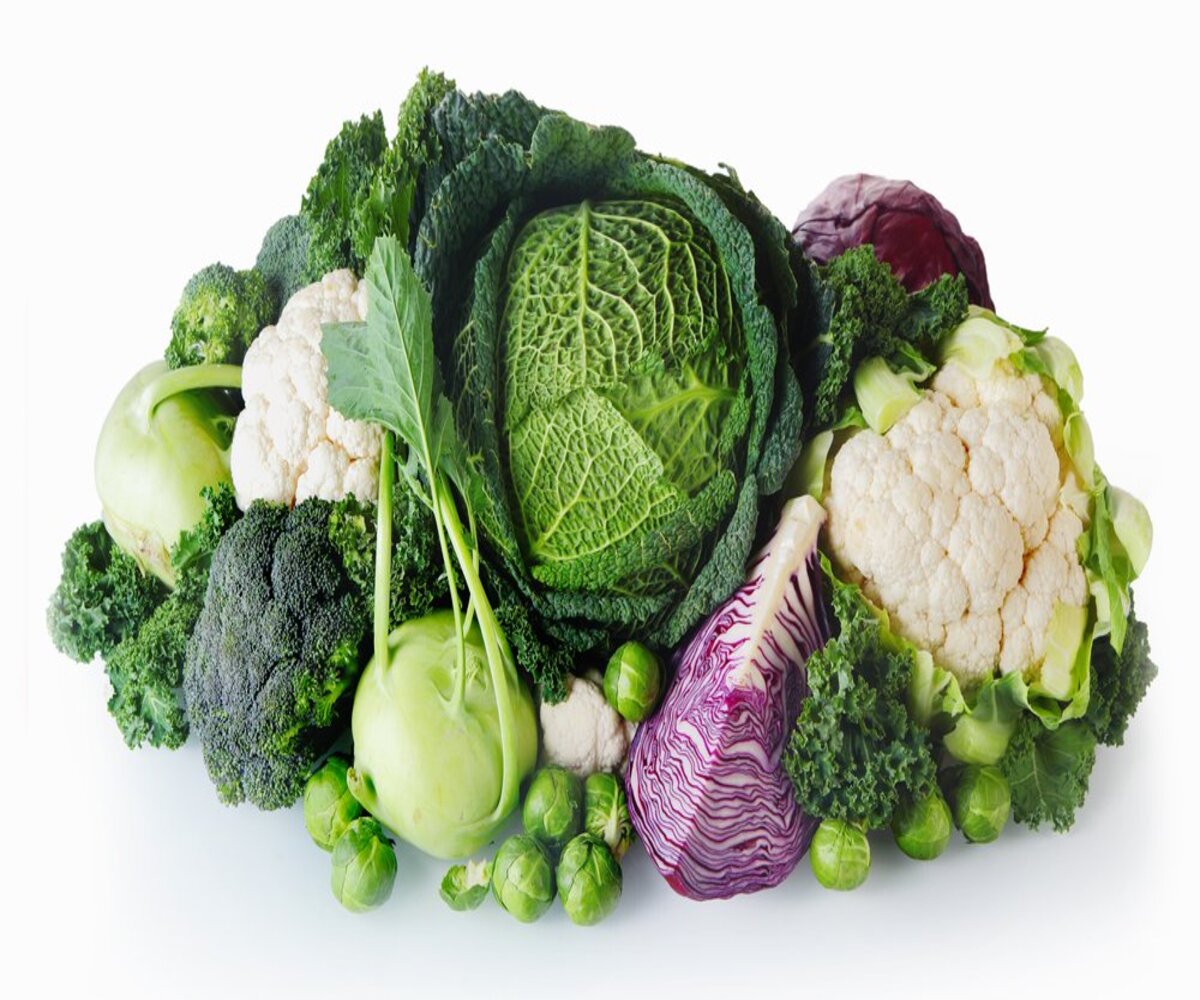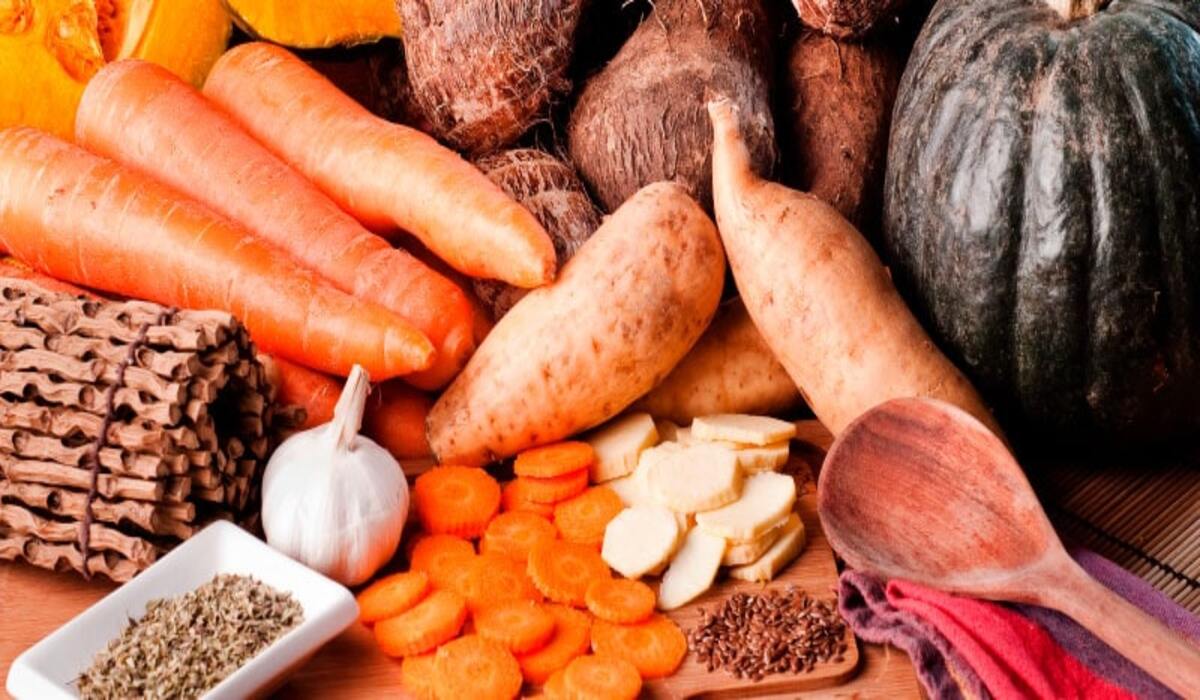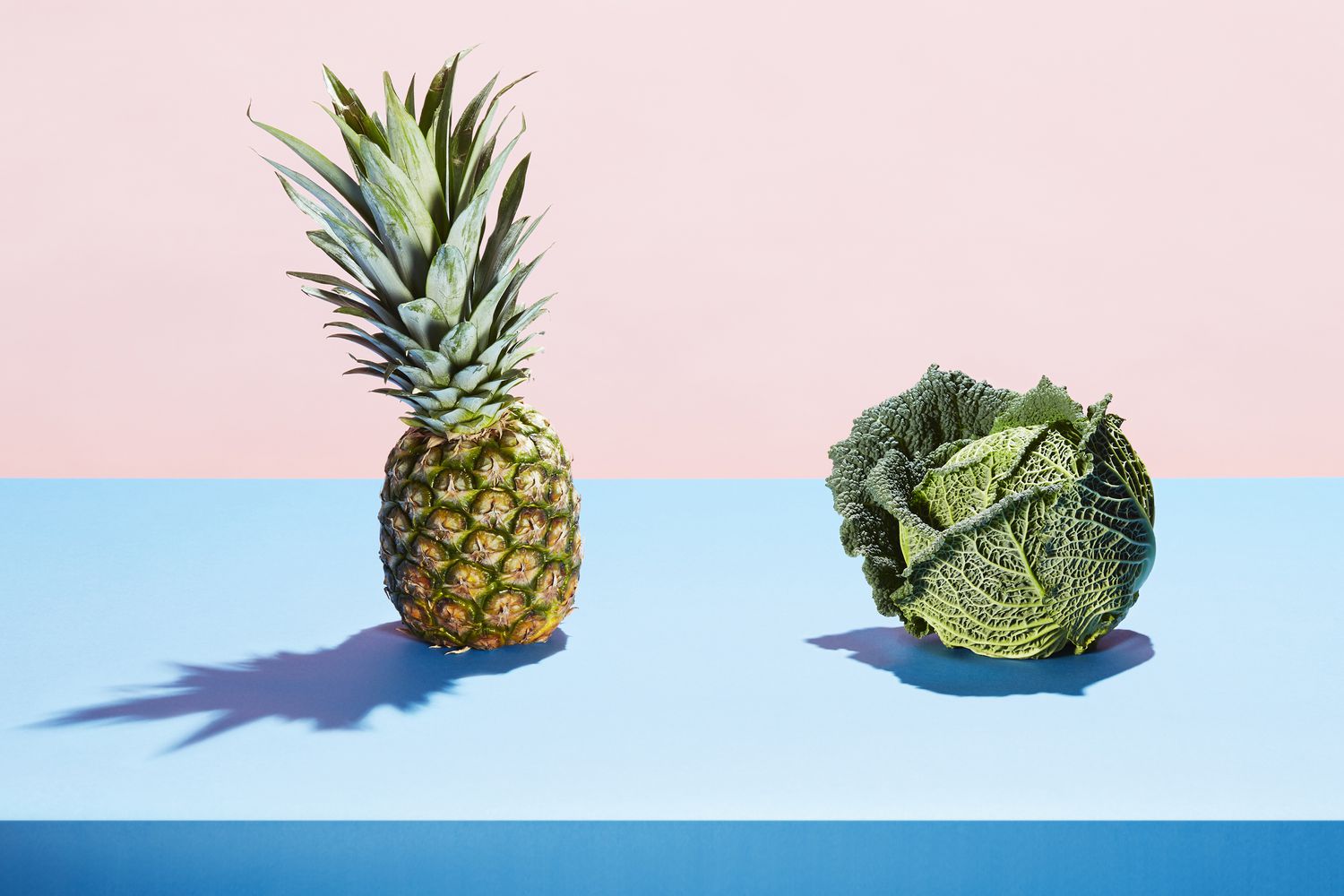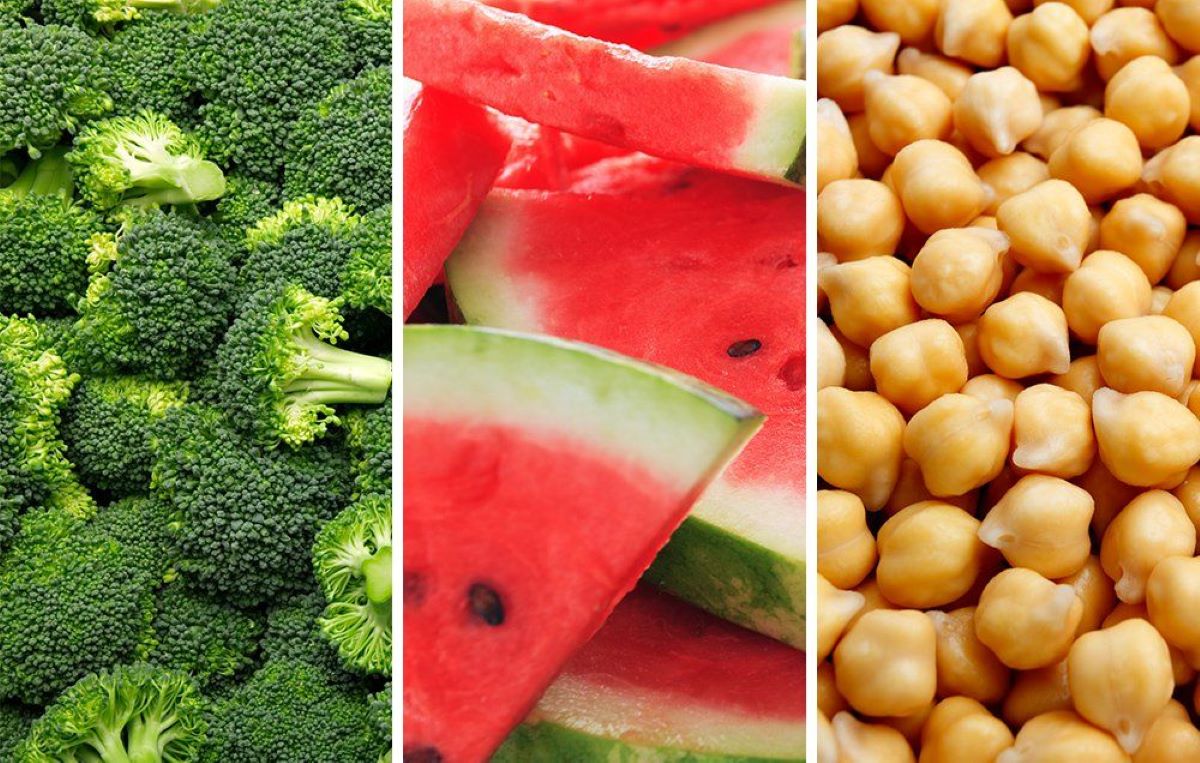Home>Gardening News and Trends>Latest News>What Fruit And Vegetables Have Protein
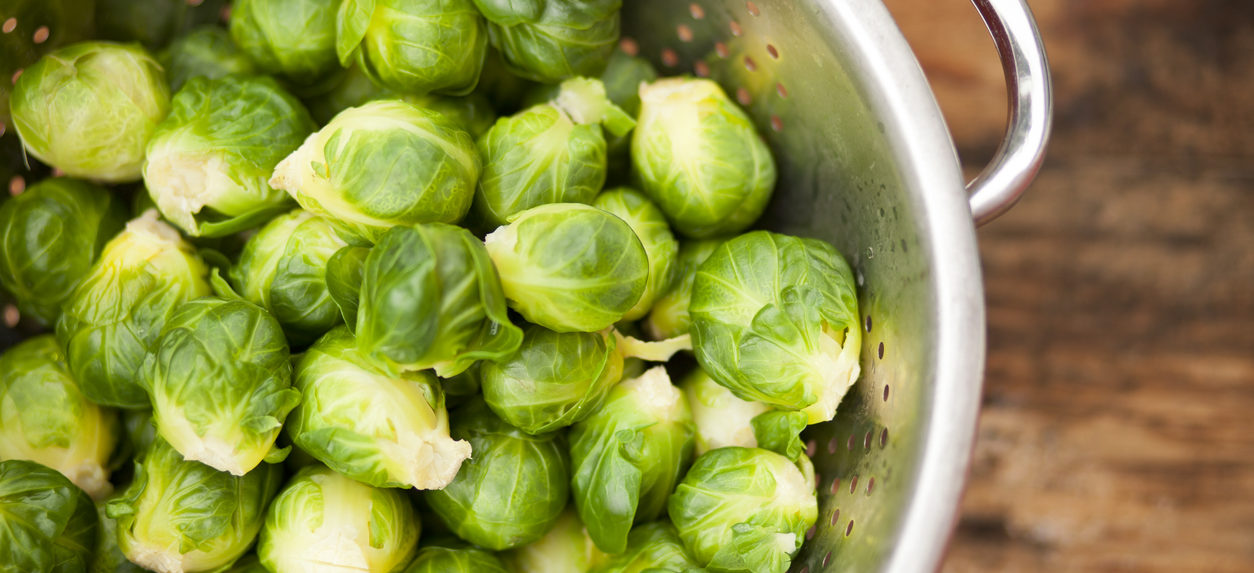

Latest News
What Fruit And Vegetables Have Protein
Modified: January 22, 2024
Discover the latest news on fruits and vegetables rich in protein. Find out which nutritious options can help you meet your health and fitness goals.
(Many of the links in this article redirect to a specific reviewed product. Your purchase of these products through affiliate links helps to generate commission for Chicagolandgardening.com, at no extra cost. Learn more)
Table of Contents
Introduction
Eating a balanced diet is crucial for maintaining good health and well-being. While protein is often associated with animal products such as meat, dairy, and eggs, many people are unaware that fruits and vegetables also contain protein. Including a variety of protein-rich foods in your diet is essential for meeting your daily nutritional needs.
Protein is a macronutrient that plays a vital role in building and repairing tissues, producing enzymes and hormones, and supporting a healthy immune system. It is made up of amino acids, which are the building blocks for our body’s cells. While animal products are considered complete proteins, meaning they contain all the essential amino acids, several fruits and vegetables also provide a good amount of protein, although they may be incomplete sources.
Adding protein-rich fruits and vegetables to your meals not only helps you meet your protein requirements but also provides a host of other benefits. Fruits and vegetables are packed with essential vitamins, minerals, and antioxidants, making them a valuable addition to any diet.
In this article, we will explore some of the best fruits and vegetables that are surprisingly high in protein content. From leafy greens to vibrant fruits, these options will not only provide you with a delicious way to incorporate protein into your diet but also contribute to your overall health and well-being. So, let’s dive in and discover the protein-enriched world of fruits and vegetables!
Importance of Protein in a Balanced Diet
Protein is an essential macronutrient that plays numerous important roles in our bodies. It is involved in the growth, repair, and maintenance of tissues, as well as the production of enzymes, hormones, and antibodies. Including an adequate amount of protein in your diet is vital to support overall health and well-being.
One of the key benefits of protein is its role in muscle growth and maintenance. When we exercise, our muscles undergo stress and microdamage. Protein provides the necessary amino acids to repair and rebuild these muscles, promoting their growth and strength. This is particularly important for individuals who engage in regular physical activity or resistance training.
Protein also plays a crucial role in weight management. Including protein-rich foods in your diet can help increase feelings of fullness and reduce appetite, which can be beneficial for weight loss or weight maintenance. Protein has a higher thermic effect of food compared to carbohydrates and fats, meaning that the body burns more calories to digest and process protein.
Furthermore, protein is essential for the proper function of our immune system. It helps produce antibodies that defend against infections and diseases, making it crucial for maintaining a healthy immune response. Protein is also involved in the production of enzymes and hormones that regulate various bodily processes, such as metabolism and digestion.
Additionally, protein is necessary for proper nutrient absorption. It plays a role in the transport and utilization of essential vitamins and minerals in our body. Without adequate protein intake, the absorption of these vital nutrients may be compromised.
Lastly, protein is necessary for the maintenance of healthy hair, skin, and nails. It provides the building blocks for the production of keratin, a protein that gives structure to these tissues. Including protein-rich foods in your diet can help promote healthy hair and skin, while inadequate protein intake may lead to brittle hair and nails, as well as dull skin.
Overall, including an adequate amount of protein in a balanced diet is essential for optimal health and well-being. It not only supports muscle growth and repair but also aids in weight management, boosts immune function, supports nutrient absorption, and promotes healthy hair, skin, and nails. Now that we understand the importance of protein, let’s explore some fruits and vegetables that are surprisingly high in protein content!
Fruits and Vegetables with Protein Content
When it comes to protein-rich foods, fruits and vegetables may not be the first things that come to mind. However, several plant-based options offer a surprising amount of protein. Including these fruits and vegetables in your diet can help you meet your protein requirements while enjoying a variety of flavors and textures.
Here are some fruits and vegetables that are surprisingly high in protein:
- Spinach: This leafy green powerhouse is not only rich in iron and vitamins, but it also contains a significant amount of protein. One cup of cooked spinach provides around 5 grams of protein. Add spinach to your salads, smoothies, or sautéed dishes to increase your protein intake.
- Broccoli: Known for its high fiber content, broccoli is also a good source of protein. One cup of chopped broccoli contains approximately 3 grams of protein. Enjoy it steamed, roasted, or in stir-fries to boost your protein intake.
- Brussels sprouts: These mini cabbages are not only delicious but also packed with protein. One cup of cooked Brussels sprouts provides around 4 grams of protein. Roast them with olive oil and seasonings for a flavorful side dish.
- Peas: Peas are not only a versatile and tasty vegetable but also a great source of protein. One cup of cooked peas contains approximately 8 grams of protein. Add them to soups, salads, or stir-fries for an extra dose of protein.
- Avocado: While avocados are best known for their healthy fats, they also offer a notable amount of protein. One medium-sized avocado contains around 4 grams of protein. Enjoy avocados in salads, sandwiches, or as a creamy topping on toast.
- Kiwi: Kiwis are not only refreshing and packed with vitamin C, but they also contain a surprising amount of protein. One medium-sized kiwi provides approximately 1 gram of protein. Enjoy them on their own, in fruit salads, or as a topping for yogurt or smoothies.
- Guava: Guava is a tropical fruit that is not only delicious but also loaded with nutrients, including protein. One cup of guava contains around 4 grams of protein. Enjoy guava as a snack, in smoothies, or as a topping for yogurt or oatmeal.
- Blackberries: These juicy berries are not just high in antioxidants; they also offer a decent amount of protein. One cup of blackberries provides approximately 2 grams of protein. Enjoy them as a snack, in smoothies, or sprinkled over cereals and desserts.
- Pomegranate: Pomegranate is not only a vibrant and delicious fruit but also a good source of protein. One medium-sized pomegranate contains around 3 grams of protein. Enjoy the juicy seeds on their own, in salads, or as a topping for yogurt and oatmeal.
- Tomatoes: Tomatoes are not only a versatile ingredient in countless dishes but also offer a small amount of protein. One cup of chopped tomatoes contains approximately 1 gram of protein. Enjoy tomatoes in salads, sandwiches, sauces, or roasted with olive oil and herbs.
These fruits and vegetables are just a few examples of the plant-based options that can contribute to your protein intake. By incorporating a variety of protein-rich fruits and vegetables into your diet, you can ensure that you meet your nutritional needs while enjoying a wide range of flavors and textures.
Spinach
Spinach is a leafy green vegetable that is not only incredibly nutritious but also surprisingly high in protein. It is a versatile ingredient that can be enjoyed in a variety of dishes, from salads to smoothies and stir-fries to soups.
One of the standout features of spinach is its protein content. One cup of cooked spinach provides approximately 5 grams of protein, making it a valuable addition to a protein-rich diet. This amount may vary slightly depending on the cooking method and the size of the spinach leaves.
Not only is spinach protein-packed, but it is also rich in a variety of essential nutrients. It is an excellent source of vitamins A, C, and K, as well as folate, iron, and calcium. These nutrients contribute to overall health and well-being, supporting immune function, bone health, and blood clotting.
Adding spinach to your meals is a great way to boost your protein intake without adding a significant amount of calories. Spinach is low in calories and carbohydrates, making it ideal for those who are watching their weight or following a low-carb diet.
There are numerous ways to incorporate spinach into your meals. You can enjoy it raw in salads, adding a burst of freshness and crunch. Sautéed spinach makes a delicious side dish or a hearty addition to omelets and stir-fries. You can also blend spinach into smoothies or soups for added nutrients and a vibrant green color.
For a protein-packed meal or snack, you can create a spinach salad by combining fresh spinach leaves with protein sources such as grilled chicken, tofu, or chickpeas. Top it off with your favorite dressing and some additional veggies or nuts for added flavor and texture.
It’s important to note that while spinach is high in protein, it is not considered a complete protein source. This means that it does not contain all the essential amino acids that our body needs. However, by incorporating a variety of other plant-based protein sources into your diet, such as legumes, nuts, and whole grains, you can ensure that you are getting a complete range of amino acids.
Incorporating protein-rich spinach into your meals is not only a healthy choice but also a delicious one. Its versatility and nutrient profile make it a valuable addition to any balanced diet. By enjoying spinach regularly, you can reap the benefits of its protein content while enjoying the variety of flavors and textures it offers.
Broccoli
Broccoli is a nutrient-dense vegetable that is not only known for its high fiber content but also for its surprising protein content. This cruciferous vegetable is packed with essential vitamins, minerals, and antioxidants, making it a valuable addition to a balanced diet.
When it comes to protein, broccoli holds its own. One cup of chopped broccoli contains approximately 3 grams of protein. This may seem small in comparison to animal-based protein sources, but it is a significant amount for a vegetable. Incorporating broccoli into your meals can be an excellent way to add plant-based protein to your diet.
In addition to protein, broccoli is rich in other essential nutrients. It is an excellent source of vitamin C, providing more than the daily recommended intake in one serving. Broccoli is also a good source of vitamin A, vitamin K, folate, and potassium. These nutrients support immune function, bone health, heart health, and overall well-being.
One of the great things about broccoli is its versatility. It can be enjoyed in a variety of ways, from steamed and stir-fried to roasted and raw. Steaming is a popular cooking method as it helps retain the vegetable’s nutrients while maintaining a crisp texture. Adding some lemon juice or a sprinkle of olive oil and seasoning can enhance the flavor of steamed broccoli.
You can also roast broccoli in the oven to bring out a slightly nutty flavor and create a delicious caramelized texture. Tossing broccoli florets with olive oil, garlic, salt, and pepper before roasting at high heat until tender and slightly browned can result in a flavorful side dish or addition to salads and grain bowls.
Incorporating broccoli into stir-fries and pasta dishes is another tasty way to enjoy this versatile vegetable. Its mild flavor pairs well with various sauces and seasonings, making it a favorite ingredient in many recipes.
For those looking to increase their protein intake, combining broccoli with other protein sources can create a well-rounded, nutritious meal. Adding tofu, chickpeas, or cooked quinoa to a broccoli stir-fry or salad can provide a satisfying and protein-rich dish.
It’s important to note that while broccoli is a good source of protein among vegetables, it is not considered a complete protein. To ensure you’re getting all the essential amino acids, it’s recommended to combine broccoli with other protein sources throughout the day.
With its surprising protein content and numerous health benefits, broccoli is a vegetable worth including in your diet. Whether enjoyed steamed, roasted, or added to your favorite dishes, broccoli is a versatile and nutritious addition to any meal.
Brussels Sprouts
Brussels sprouts may be small in size, but they pack a powerful nutritional punch. These miniature cabbage-like vegetables are not only rich in fiber and vitamins but also surprisingly high in protein. Including Brussels sprouts in your diet can provide a delicious and protein-rich addition to your meals.
One cup of cooked Brussels sprouts contains approximately 4 grams of protein, making it a noteworthy source of plant-based protein. This protein content, combined with its low calorie and carbohydrate content, makes Brussels sprouts a fantastic choice for those looking to increase their protein intake without compromising their overall calorie goals.
In addition to being a protein source, Brussels sprouts are packed with essential nutrients. They are an excellent source of vitamin C, vitamin K, vitamin A, folate, and fiber. These nutrients play a crucial role in supporting immune function, promoting bone health, aiding in digestion, and maintaining healthy vision.
To enjoy the full flavor and nutritional benefits of Brussels sprouts, it’s important to prepare them properly. Roasting is a popular method of cooking Brussels sprouts as it enhances their natural sweetness and creates a delightful caramelized texture. Simply toss Brussels sprouts with olive oil, salt, pepper, and any desired seasonings before roasting in the oven until they are crispy on the outside and tender on the inside.
Another delicious way to enjoy Brussels sprouts is by sautéing them. Heat a pan with some olive oil, garlic, and onion, then add halved or shredded Brussels sprouts and cook until they are lightly browned and tender. Adding a dash of lemon juice or a sprinkle of parmesan cheese can elevate their flavor even further.
For a protein-packed meal, consider combining Brussels sprouts with other protein sources. Adding grilled chicken, roasted tofu, or chickpeas to a dish featuring Brussels sprouts can provide a complete and satisfying meal that is rich in both protein and flavors.
Brussels sprouts can also be enjoyed raw. Thinly slice or shred the sprouts and toss them into salads or coleslaws for an added crunch and a boost of protein. The unique flavor and texture of raw Brussels sprouts can bring a refreshing twist to your salads.
With their surprising protein content and plethora of essential nutrients, Brussels sprouts offer a nutritious and flavorful addition to any diet. Whether enjoyed roasted, sautéed, or raw, these small but mighty vegetables provide a delicious way to incorporate more protein into your meals.
Peas
Peas are not only a versatile and tasty vegetable, but they also offer a significant amount of protein. These small, spherical legumes are packed with essential nutrients and can be enjoyed in various dishes, from soups and salads to stir-fries and side dishes.
One cup of cooked peas contains approximately 8 grams of protein, making them an excellent source of plant-based protein. This protein content, combined with their low fat and calorie content, makes peas a great choice for those seeking to increase their protein intake while maintaining a balanced diet.
In addition to being a protein powerhouse, peas are rich in other essential nutrients. They are loaded with vitamins C and K, as well as folate, iron, and dietary fiber. These nutrients contribute to immune health, blood clotting, energy production, and maintaining a healthy digestive system.
Peas are a versatile vegetable that can be incorporated into a variety of meals. They can be enjoyed in their whole form or pureed to create delicious and nutritious dishes. Whole peas can be added to salads, soups, or stir-fries to provide a burst of sweetness and texture.
Pureed peas make a fantastic base for sauces and dips, adding creaminess and a hint of natural sweetness. You can use pureed peas as a spread on sandwiches or as a dip for vegetable crudités or crackers. The vibrant green color of pea puree also adds an appealing visual element to any dish.
Another popular way to enjoy peas is by adding them to grain-based dishes such as rice or pasta. Peas can be mixed into risottos, fried rice, or pasta salads to enhance the nutritional value and add a pop of color and flavor.
For a protein-rich meal, consider combining peas with other protein sources. Adding cooked peas to dishes that feature grilled chicken, tofu, or lentils can create a well-rounded and satisfying meal that provides a complete range of essential amino acids.
Peas can also be enjoyed as a snack on their own. Frozen peas make a refreshing and nutritious snack straight from the freezer. They can be thawed and enjoyed as is or added to trail mix for an extra boost of protein and fiber.
Whether added to salads, pureed into dips, or enjoyed as a snack, peas offer a delightful way to incorporate protein into your diet. Their versatility, sweet flavor, and impressive nutrient content make peas a valuable addition to any meal.
Avocado
Avocado is well-known for its healthy fats and creamy texture, but it might surprise you to learn that it also contains a notable amount of protein. This unique fruit offers more than just a rich flavor—it also provides several health benefits and can be a valuable addition to a protein-rich diet.
One medium-sized avocado contains approximately 4 grams of protein, making it a significant source of plant-based protein. Avocados are unique in that they provide all nine essential amino acids, making them a complete protein source. These amino acids are necessary for the body to function properly and are essential for building and repairing tissues, producing enzymes, and supporting a healthy immune system.
In addition to protein, avocados are packed with essential nutrients. They are an excellent source of heart-healthy monounsaturated fats, which can help reduce bad cholesterol levels and promote overall cardiovascular health. Avocados also provide a good amount of fiber, potassium, vitamins C, E, K, and various B vitamins.
Avocados are incredibly versatile and can be enjoyed in numerous ways. They can be sliced and added to salads, mashed and spread on toast, or blended into delicious smoothies and smoothie bowls. Avocado can also be used as a substitute for butter or oil in baking and cooking, adding a creamy texture and a boost of nutrition to your favorite recipes.
When it comes to incorporating avocado into your diet, portion control is key due to its higher calorie content. A moderate amount of avocado can add a satisfying element to your meals while providing a good dose of protein and healthy fats. Pairing avocado with other protein sources, such as grilled chicken or chickpeas, can create a balanced and protein-rich meal.
Avocado is not only delicious but also incredibly satiating. Its combination of healthy fats, protein, and fiber can help keep you feeling full and satisfied, making it a great addition to meals if you’re looking to manage your appetite or maintain a healthy weight.
So, next time you enjoy some avocado on your toast or in your salad, remember that you’re not only adding a creamy and flavorful ingredient but also benefiting from its protein content and array of essential nutrients. Incorporating avocado into your diet can be a nutritious and delicious way to increase your protein intake.
Kiwi
Kiwi is a vibrant and refreshing fruit that is well-known for its high vitamin C content. But did you know that kiwi also contains a surprising amount of protein? This small fruit can provide a delicious and protein-rich addition to your diet.
One medium-sized kiwi provides approximately 1 gram of protein, making it a modest source of plant-based protein. While the protein content may seem small compared to other sources, kiwi offers many other health benefits and nutrients that make it worth including in your diet.
In addition to protein, kiwi is packed with essential vitamins and minerals. It is an excellent source of vitamin C, providing over 100% of the daily recommended intake in one serving. Kiwi is also a good source of dietary fiber, vitamin E, potassium, and antioxidants, which help support immune function and overall health.
The unique combination of protein and nutrients in kiwi make it a valuable fruit for maintaining a balanced and nutritious diet. Including kiwi in your meals can also contribute to healthy digestion and overall well-being.
One of the great things about kiwi is its versatility. It can be enjoyed on its own as a refreshing and nutrient-dense snack, or added to a variety of dishes for a burst of flavor and texture.
Sliced or diced, kiwi pairs well with other fruits in fruit salads or smoothies, adding a tropical and tangy element. You can also add kiwi slices to yogurt, oatmeal, or chia pudding for a protein-rich and satisfying breakfast or snack.
Another creative way to enjoy kiwi is by using it as a topping for savory dishes. The natural acidity and sweetness of kiwi can complement the flavors of grilled meats, seafood, or salads, making it a unique and delicious addition to savory meals.
It’s important to note that while kiwi contains protein, it is not considered a significant source of protein on its own. However, incorporating kiwi into a well-rounded and balanced diet that includes other protein sources can contribute to meeting your overall protein needs.
With its refreshing taste and surprising protein content, kiwi is a fruit worth incorporating into your diet. Whether enjoyed on its own, added to salads or smoothies, or used as a topping for savory dishes, kiwi can provide a tasty and protein-rich addition to your meals.
Guava
Guava is a tropical fruit known for its distinct flavor and fragrance. Not only is it delicious, but guava also offers a surprising amount of protein. This unique fruit provides a tasty and protein-rich addition to your diet.
One cup of guava contains approximately 4 grams of protein, making it a notable source of plant-based protein. This protein content, combined with its low calorie and fat content, makes guava an excellent option for those looking to increase their protein intake while maintaining a healthy diet.
In addition to protein, guava is rich in other essential nutrients. It is an excellent source of vitamin C, providing more than double the daily recommended intake in one serving. Guava is also a good source of dietary fiber, antioxidants, and various minerals such as potassium and manganese.
Enjoying guava can be a delightful experience in itself. Simply peel the fruit and eat it fresh or slice it for an easy and healthy snack. Guava can also be used in a variety of culinary creations, from smoothies and juices to desserts and salads.
For a refreshing and protein-rich snack, blend guava with yogurt or coconut water to create a tasty smoothie. The natural sweetness of guava pairs well with other tropical fruits such as pineapple or mango, creating a delightful and nutrient-packed drink.
Guava can also be added to fruit salads or mixed with other fruits to create a vibrant and flavorful medley. Its unique taste and texture can add a tropical twist to your favorite salad combinations.
Additionally, guava can be used to make delicious and innovative desserts. From guava ice cream to custards or tarts, this versatile fruit can add a burst of flavor and a touch of protein to your sweet treats.
It’s important to note that while guava contains protein, it should be combined with other protein sources as part of a balanced diet. This will ensure that you receive a variety of essential amino acids to meet your body’s needs.
With its tropical flavor and unexpected protein content, guava offers a unique and delicious way to incorporate protein into your diet. Whether enjoyed fresh, blended into smoothies, or used in desserts and salads, guava adds a nutritious and flavorful element to your meals.
Blackberries
Blackberries are juicy and flavorful berries that are not only delicious but also surprisingly high in protein. These dark purple berries offer a delightful and protein-rich addition to your diet, along with a multitude of health benefits.
One cup of blackberries contains approximately 2 grams of protein, making them a valuable source of plant-based protein. While the protein content may not be as high as other sources, blackberries make up for it with their abundance of vitamins, minerals, and antioxidants.
In addition to protein, blackberries are packed with essential nutrients. They are rich in dietary fiber, vitamin C, vitamin K, and manganese. Blackberries also contain high levels of antioxidants, which help protect against cell damage and support overall health.
Blackberries can be enjoyed in various ways, making them a versatile fruit to incorporate into your meals and snacks. They can be eaten fresh and raw, added to smoothies, baked into pies or tarts, or used in sauces and jams.
Adding blackberries to your breakfast can be a nutritious way to start your day. Sprinkle them on top of yogurt or oatmeal, or blend them into a smoothie, to enjoy their sweet and tangy flavor while boosting your protein intake.
Blackberries can also be incorporated into salads for a burst of flavor and a touch of protein. Toss them with mixed greens, goat cheese, and a drizzle of balsamic vinaigrette for a refreshing and nutritious salad option.
One of the great things about blackberries is that they can be frozen and enjoyed later. Freezing blackberries helps preserve their nutritional content and makes them perfect for adding to smoothies, desserts, or even enjoying as a frozen treat on a hot day.
It’s important to remember that while blackberries contain protein, they are not a significant source of protein on their own. Combining blackberries with other protein-rich foods, such as Greek yogurt or nuts, can create a well-rounded and satisfying snack.
With their sweet and tart taste, blackberries offer a nutritious and delicious way to incorporate protein into your diet. Whether eaten on their own, added to various dishes, or frozen for later use, blackberries provide a delightful and protein-rich addition to your meals and snacks.
Pomegranate
Pomegranate is a delicious and visually stunning fruit that is not only refreshing but also surprisingly high in protein. This unique fruit offers a sweet and tangy flavor along with a variety of health benefits, making it a valuable addition to your diet.
One medium-sized pomegranate contains approximately 3 grams of protein, making it a noteworthy source of plant-based protein. Combined with its abundance of vitamins, minerals, and antioxidants, pomegranate is a nutritious fruit choice.
In addition to protein, pomegranate is rich in other essential nutrients. It is a great source of vitamin C, providing more than 40% of the daily recommended intake in one pomegranate. Pomegranate is also a good source of fiber, vitamin K, folate, and potassium, all of which contribute to overall health and well-being.
Enjoying pomegranate can be a delightful experience. The seeds, or “arils,” are the edible part of the fruit and provide a burst of juiciness and flavor. Simply cut open a pomegranate and remove the seeds, then eat them on their own or add them to a variety of dishes.
One of the most popular ways to enjoy pomegranate seeds is by adding them to salads. Their vibrant color and sweet-tart taste can enhance the flavor and visual appeal of any salad creation. Pair them with leafy greens, feta cheese, and a citrus vinaigrette for a refreshing and protein-rich salad.
Pomegranate seeds can also be added to yogurt or oatmeal for a delicious and nutritious breakfast option. They can provide a delightful crunch and a burst of flavor, elevating your morning meal to new heights.
Another creative way to enjoy pomegranate is by incorporating it into smoothies or juices. Blend the seeds with other fruits, such as berries or tropical fruits, or simply juice the pomegranate for a refreshing and protein-rich beverage.
Pomegranate can also be used in savory dishes. It can be added to grain bowls, roasted vegetables, or as a topping for grilled chicken or fish, creating a unique and flavorful component to your main courses.
It’s important to note that while pomegranate contains protein, it is not considered a significant source of protein on its own. Pairing pomegranate with other protein sources, such as Greek yogurt or nuts, can create a well-rounded and protein-rich snack.
With its enticing flavor and hidden protein content, pomegranate adds a delightful and nutritious element to your meals and snacks. Whether enjoyed on its own, added to salads or smoothies, or used in various savory dishes, pomegranate is a versatile fruit that can increase your protein intake while tantalizing your taste buds.
Tomatoes
Tomatoes are a staple in many cuisines and are known for their versatility and vibrant flavor. While often considered a vegetable, tomatoes are technically a fruit and are surprisingly high in protein. These juicy and nutritious fruits offer a delicious and protein-rich addition to your meals.
One cup of chopped tomatoes contains approximately 1 gram of protein, making them a modest but valuable source of plant-based protein. Tomatoes also offer a variety of other essential nutrients, including vitamin C, vitamin A, potassium, and antioxidants.
In addition to their protein content, tomatoes are recognized for their powerful antioxidant properties. They contain lycopene, a potent antioxidant that helps protect against cellular damage and is associated with various health benefits, including a reduced risk of certain cancers and heart diseases.
Tomatoes are incredibly versatile and can be enjoyed in countless ways. They can be eaten raw in salads, sandwiches, or salsas, providing a burst of flavor and juiciness. Cherry tomatoes make a convenient and nutritious snack on their own or paired with cheese or hummus.
Roasting or grilling tomatoes can enhance their natural sweetness and create a rich and savory flavor. Roasted tomatoes can be used as a topping for bruschetta, added to pasta dishes, or blended into a delicious tomato sauce.
Tomatoes can also be used as a base for soups, stews, or sauces, adding depth and richness to the overall flavor profile. Gazpacho, a chilled tomato-based soup, is a refreshing and protein-rich option for warm weather.
When it comes to incorporating tomatoes into your meals, consider pairing them with other protein sources for a complete and balanced dish. Combining tomatoes with protein-rich ingredients such as grilled chicken, tofu, or beans can create a satisfying meal that provides the necessary amino acids.
It’s worth noting that while tomatoes contain protein, they are not considered a significant source of protein on their own. However, incorporating tomatoes into your diet alongside other protein-rich foods can contribute to meeting your overall protein needs.
With their vibrant color, refreshing flavor, and protein content, tomatoes offer a valuable addition to any meal. Whether enjoyed raw, roasted, or as a base for savory dishes, tomatoes provide a nutritious and delicious way to incorporate protein into your diet.
Conclusion
Incorporating a variety of protein-rich fruits and vegetables into your diet not only provides essential nutrients but also diversifies your meals with vibrant colors and flavors. While animal products are often the go-to sources of protein, fruits and vegetables can surprise you with their protein content.
Spinach, broccoli, Brussels sprouts, peas, avocado, kiwi, guava, blackberries, pomegranate, and tomatoes are just a handful of examples of fruits and vegetables that offer protein in addition to their other benefits. Including these protein-rich options in your meals can help you meet your protein needs while enjoying a wide range of flavors and textures.
Protein plays a crucial role in our body, from building and repairing tissues to producing enzymes and hormones. It supports muscle growth, aids in weight management, boosts immune function, and contributes to the absorption of essential nutrients. Therefore, ensuring an adequate protein intake is essential for overall health and well-being.
While fruits and vegetables may not be complete protein sources on their own, combining them with other plant-based protein sources such as legumes, nuts, and whole grains can provide all the essential amino acids our body needs. This allows for a varied and balanced protein intake.
So, whether you’re adding spinach to your salads, enjoying creamy avocado on toast, or incorporating the tangy sweetness of pomegranate into your meals, have fun exploring the protein-rich world of fruits and vegetables. Experiment with different combinations and preparations to find your favorite ways to include these nutrient-packed foods in your diet.
Remember that a well-rounded and balanced diet includes a variety of macronutrients, and protein is an important component of that equation. By incorporating protein-rich fruits and vegetables, you can make your meals not only nutritious but also exciting and flavorful.
So, go ahead and embrace the protein power of fruits and vegetables, and let them contribute to your quest for a healthier and more balanced lifestyle.
